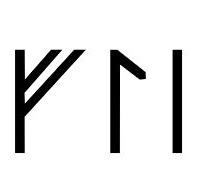
Viking Names
Ulfljot
The Old Norse female personal name Úlfljót is comprised of the element Úlf– ‘wolf’ and the element -ljót which is also attested as the simplex female personal name Ljót. Although Úlfljót is not otherwise attested, the masculine equivalent Úlfljótr is recorded in Iceland and possibly Yorkshire. John Hines has suggested that the female name is inscribed in runes on the Saltfleetby spindle whorl found at Saltfleetby St Clement, Lincolnshire, which he has translated as ‘Óðinn and Heimdallr and Þalfa, they are helping you, Úlfljót…’.
Read More
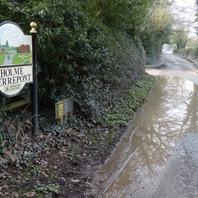
Viking Names
Holme Pierrepont
Holme Pierrepont, in the Bingham Wapentake of Nottinghamshire, comes from Old Norse holmr ‘an island, an inland promontory, raised ground in marsh, a river-meadow’. The name describes its location which is surrounded by watercourses and dikes. The suffix Pierrepont was added at a later date to reflect the family connected to the location. For more information about holmr place-names in the East Midlands, see the Lunchtime Talk Holme from Home? East Midland Place-Names and the Story of Viking Settlement.
Read More

Viking Names
Thorarna
Þórarna is a Old Norse compound name with the first element Þór-, from the name of the god Þórr ‘Thor’ (very common in both male and female names), combined with -arna, the feminine form of -arinn, either from arinn ‘hearth’ or more probably the postulated element *arin related to ǫrn ‘eagle’. A couple of instances of Þórarna are recorded in Norway with one of the earliest being from the ninth century. The name is frequent in Iceland evidenced by the multiple mentions in Landnámabók ‘The Book of Settlements’, a quasi-historical text which recounts the settlement of Iceland. Þórarna is not attested in Denmark or Sweden. There is a form of the name found in the Yorkshire Domesday, but it may alternatively represent the male name Þórormr.
Read More
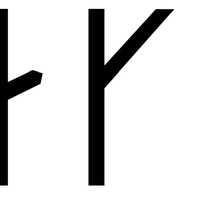
Viking Names
Ragni
Ragni is a short form of names in Ragn-, related to Old Norse regin, genitive plural ragna, ‘ruling powers, the gods’. The personal name element probably has the sense of ‘advice’, but it may indicate ‘the gods’, as it does in Ragnarök, the name of the apocalypse in Old Norse mythology. A few late instances of the personal name are recorded in West Scandinavia, it is recorded in several runic inscriptions in Sweden. Also, Ragni is the first element of the place-name Ragnall, Nottinghamshire.
Read More
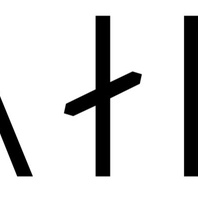
Viking Names
Havard
Hávarðr is a compound name formed from Há- which has three potential origins of ‘horse’, ‘high’, or ‘battle’ and -varðr ‘guard, watchman’. The name is found in West Scandinavia at the time of the settlement of Iceland and is very common in Norway from the thirteenth century onwards. The name is also recorded in Sweden and Denmark. Hávarðr is the first element in the place-name of Hawerby, Lincolnshire.
Read More
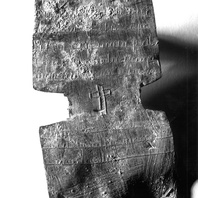
Viking Objects
Inscribed Lead Plaque (LCNCC:1996.64.045)
This lead plaque of uncertain function has a cross incised in its centre and a long Latin text in the Roman alphabet. Like the Saltfleetby spindle whorl, this inscription, too, calls on a divine power, in this case Christ. Between them the two inscriptions represent different responses to literacy and religion in the same time period in neighbouring but probably different communities. (Cumberworth is about 15 miles south of Saltfleetby, in an area with many Scandinavian place-names.) This fragmentary inscription begins with a cross and XPI, the sign for Christ, and after a gap in the text ends with ‘he who by the power of the cross redeemed the world from death, shattered hell or threw open heaven’. The object is dated to the late 10th or 11th century on the basis of the similarity of the writing to contemporary manuscripts.
Read More
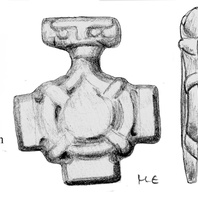
Viking Objects
Die Stamp (NLM-690F57)
This cast copper-alloy die was used in the process of making filigree pendants of the Hiddensee-Rügen type, more specifically, to create pressed silver or gold sheet appliqués, which were applied to a pendant back-plate and used as a base for filigree and granulation work. The ring in the centre creates a closed ring-knot motif related to the Scandinavian Borre style. The Hiddensee-Rügen style is named after the gold jewellery hoard discovered in the late nineteenth century on the island of Hiddensee, off the Baltic coast of Germany. The Swinhope die is one of a small group of recorded objects used in the production of Hiddensee-style cruciform pendants. No finished pendants of the type represented by the Swinhope die are known, either from England or Scandinavia.
Read More
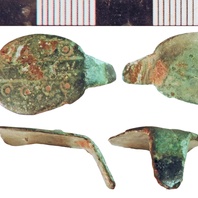
Viking Objects
Copper-Alloy Finger-Ring (NLM-D4A8C9)
A copper-alloy cast finger-ring featuring circular punched ring and dot decoration. Ring and dot was a decorative technique used at various periods from the later Iron Age onwards, but which enjoyed a Viking Age revival.
Read More
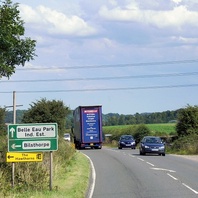
Viking Names
Bilsthorpe
Bilsthorpe, in the Bassetlaw Wapentake of Nottinghamshire, comes from the Old Norse male personal name Bildr and Old Norse þorp ‘a secondary settlement, a dependent outlying farmstead or hamlet’.
Read More

Viking Names
Svarri
The Old Norse male byname Svarri ‘capable, energetic man’ is a rare name; it is recorded once in Norway. The name is the first element in Swarby, Lincolnshire.
Read More
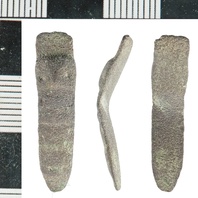
Viking Objects
Copper-Alloy Strap-End (NLM-7415FD)
This copper-alloy strap-end is decorated with vaguely zoomorphic decoration and is possibly a Thomas Class B type 4. The reddish tint of the metal is often characteristic of Anglo-Scandinavian metalwork. Strap-ends came in various styles and were fairly common throughout the Viking world. They were used to decorate the ends of belts and to stop them getting damaged.
